Is George Clooney right that he’s too old for romance?
How 4,325 romantic films handle big age gaps, and how it's shifting over time.
Last week George Clooney did something almost unheard of in Hollywood. He voluntarily stepped away from a genre that still might have him.
Speaking to 60 Minutes, he said:
“Look, I’m 63 years old. I’m not trying to compete with 25-year-old leading men. That’s not my job. I’m not doing romantic films anymore.”
It is not the most shocking retirement. Clooney has not exactly been churning out romcoms lately. His last major romantic outing was 2022’s Ticket to Paradise, opposite Julia Roberts. The film made a respectable $169m worldwide and prompted a flurry of think pieces about chemistry, charisma and how rare it is to see two people over 50 flirt on screen without dying or breaking up for good in the third act.
But Clooney’s comment hit a nerve. Because for decades he has been the textbook example of Hollywood’s most enduring romantic fantasy: a silver-haired man of a certain age, paired with a woman who still gets carded when buying wine.
His decision to step away therefore raises an intriguing question. Has the industry changed enough that even Clooney now feels too old to be cast as a viable romantic lead? Or is this simply a personal exit from a genre that was never built to accommodate ageing with any kind of grace?
To find out I crunched the data on 4,325 romantic films released since 1940and identified the age of the actors upon the film’s release. I used five-year rolling averages to smooth out the natural ups and downs caused by individual films. This gives us a sense of what the industry has considered normal over time.
How rare are male romantic leads over 63?
The short version is that Clooney is stepping away from a role that has barely existed to begin with. That said, the data suggests he may have received increasing offers as time goes on.
Across the 1950s and early 60s, fewer than 1% of male romantic leads were over 63. The figure flatlined for most of the 1970s. It rose slightly in the 1980s with a few notable appearances by Sean Connery and Burt Lancaster, then climbed again in the early 2010s. But even at its highest point in the last few years, only 4.9% of romantic male leads were in Clooney’s age bracket.
That is roughly one film in twenty. And even then, many of those roles were not straightforward love stories. They were more likely to involve nostalgia, grief, psychological crisis, or the kind of cautious emotional intimacy you find in films where no one says what they mean until at least the seventy-minute mark.
It is not that older men are absent from film. They are present. They are just rarely falling in love in “romantic” films.
How romantic age gaps have shaped the romantic norm
Even though men in their 60s rarely get cast as romantic leads, men in their late 30s and early 40s are still doing just fine. So are the women they are cast opposite. Although “fine” here is a relative term.
The average age of male romantic leads has hovered between 35 and 39 for most of the past eighty years. Female leads, by contrast, have stayed almost entirely within a range of 28 to 31. When women do get older roles, they are usually playing mothers or mentors or women who cry alone in bathrooms. Sometimes all three.
This steady discrepancy creates a predictable gap between the ages of heterosexual romantic leads. Since the 1940s, men have almost always been older than their love interests.
During the 1950s the average gap ballooned to more than nine years. For a brief stretch in the late 1970s, the age difference narrowed to just under four. But it crept up again in the 1990s, but now in the 21st century is in decline.
How movies explain or excuse age gaps
Across the decades, I found that most romantic films with a large age difference fall into one of six narrative approaches. Occasionally they overlap, but they each offer a different way of managing the question, even if they rarely answer it.
1. Male gaze romantic idealism
This is the most common treatment in Classical Hollywood. The age gap is there, but no one mentions it. Not the characters. Not the script. Not the camera.
Daddy Long Legs (1955). Fred Astaire at 56 courts Leslie Caron at 24. There are songs. There are smiles. There are no awkward conversations.
Bell Book and Candle (1958). James Stewart was 50. Kim Novak was 25. The film is about witches and love spells.
2. Psychological exploration
Here the age gap is not just present, it IS the story. These films tend to deal with obsession, power, and emotional instability.
Lolita (1997). Jeremy Irons was 49 and Dominique Swain was 17. The film does not pretend the relationship is romantic. It is framed as exploitative and disturbing.
The Humbling (2014). Al Pacino plays a fading actor drawn into a complicated relationship with a much younger woman. He was 74. She was 31. The story is about decline rather than desire.
3. Light-hearted humour
These films go for laughter before logic. The age gap is part of the setup but never part of the problem.
Blame It on Rio (1984). Michael Caine was 51, Michelle Johnson was 19. The plot involves an affair with his best friend’s daughter. The film is more concerned about sunburn than ethics.
Entrapment (1999). Sean Connery at 69 and Catherine Zeta-Jones at 30 carry out heists and engage in flirtation.
4. Reflections on lost youth
Here, the younger character is often less a partner than a reminder of something the older character has lost or missed.
Wild Strawberries (1957). Victor Sjöström at 78 revisits his past through a series of encounters, including one with Bibi Andersson, aged 22. The relationship is symbolic and unconsummated.
Atlantic City (1980). Burt Lancaster, 67, and Susan Sarandon, 34, share a connection built more on memory and melancholy than romance.
5. Accepting of connection
These stories acknowledge the age gap but do not treat it as an obstacle or problem. They focus on connection, not symmetry.
Limelight (1952). Charlie Chaplin and Claire Bloom play a gentle pairing of artist and muse. He was 63. She was 21. The story is about healing rather than seduction.
Cheeni Kum (2007). Amitabh Bachchan (65) and Tabu (36) portray a later-in-life romance that is warm, witty, and aware of cultural expectations.
6. Social commentary
The age difference is used to raise questions about control, gender norms, and desire. The films often make the viewer uncomfortable on purpose. This is the rarest of all the groups.
That Obscure Object of Desire (1977). Fernando Rey pursues a woman played by two actresses, both in their early twenties. He was 60. The film is more interested in obsession than outcome.
The Mother (2003). Anne Reid, 68, has an affair with Daniel Craig, 35. It is frank, uncomfortable, and refuses to turn the relationship into a punchline or tragedy.
How we have minded the gap
For those films I could tell the approach from the plot, I looked at how the culture around romantic age gaps has shifted over time.
The data reveals that while the age gap has persisted, the way filmmakers have dealt with it has moved around quite a bit.
During the 1920s and 30s, nearly half of all films with age gaps of at least 10 years treated the relationship as aspirational, with the older man as worldly and desirable, the younger woman as wide-eyed and agreeable.
Since the 1960s and 70s, psychological exploration became dominant. Over half of the films in these decades that featured a large age gap did so with a serious, often introspective tone. These were less love stories than studies in control, power, and slow emotional ruin.
Notes
This research looked at the two actors playing the lead roles in the main heterosexual romantic storyline of feature films released between 1940 and 2023, based on IMDb genre classifications.
For each film, I identified the central romantic pairing and noted the actors playing those roles. I then gathered date of birth data in order to calculate their age in the year the film was released. These figures reflect the actors' ages at release, which is usually a little older than they would have been during filming. I used five-year rolling averages to account for natural annual fluctuations.
In measuring the gap between romantic leads, I considered the two actors most central to the film’s romantic plot, based on billing and storyline. That usually meant the top-billed male and female actor, but not always. When it was not clear from the billing alone, I manually reviewed the film’s synopsis or character descriptions to identify the romantic pairing.
I focused on heterosexual romantic pairings simply because there were too few same-sex romances on record to calculate reliable year-on-year trends. Between 2000 and 2023, under 2.5% of romantic films focused on a non-heterosexual paring.
Although the sample size was much smaller, I did analyse a subset of films featuring same-sex romantic relationships. Interestingly, when gay male or female pairings do appear on screen, the leads tend to be older on average than their heterosexual counterparts.



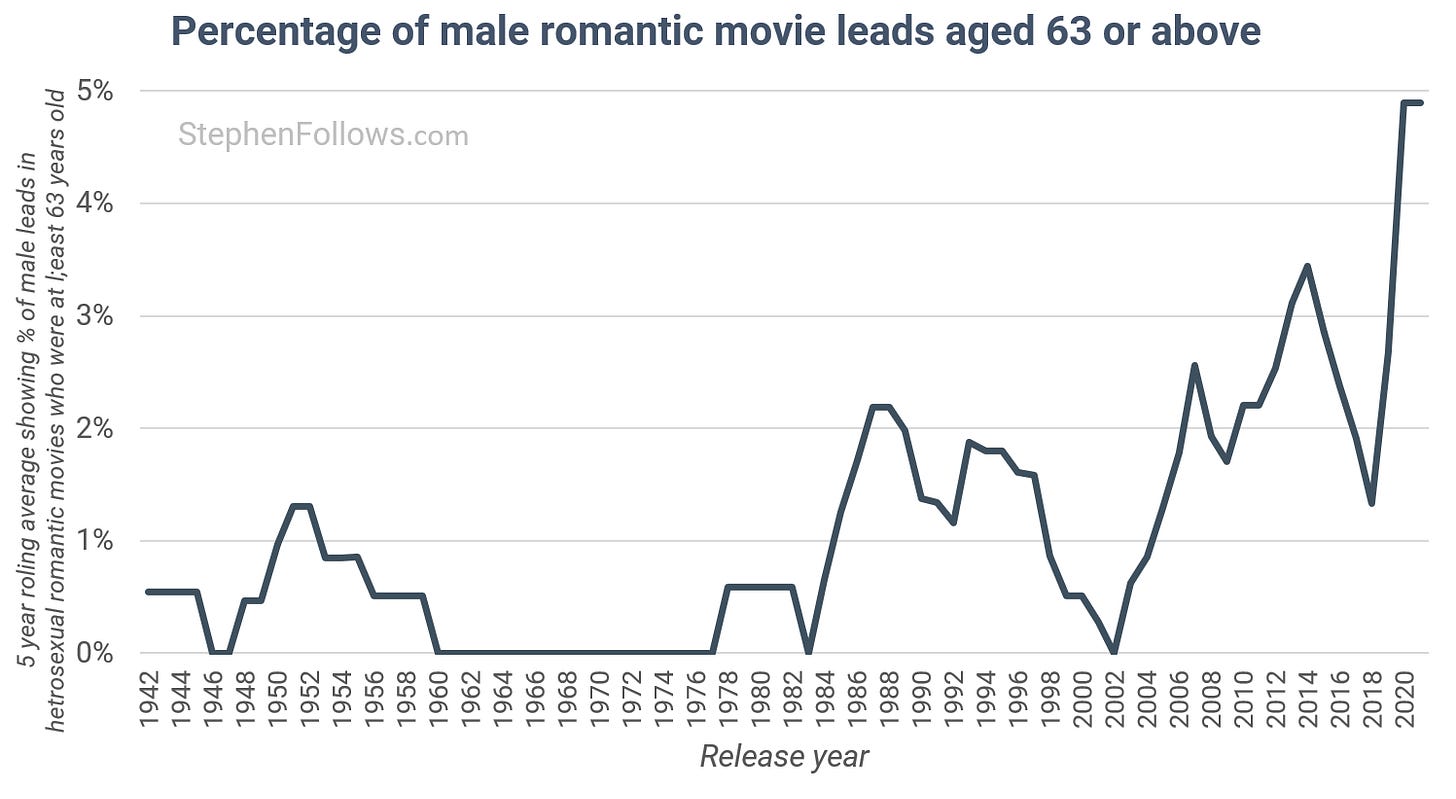
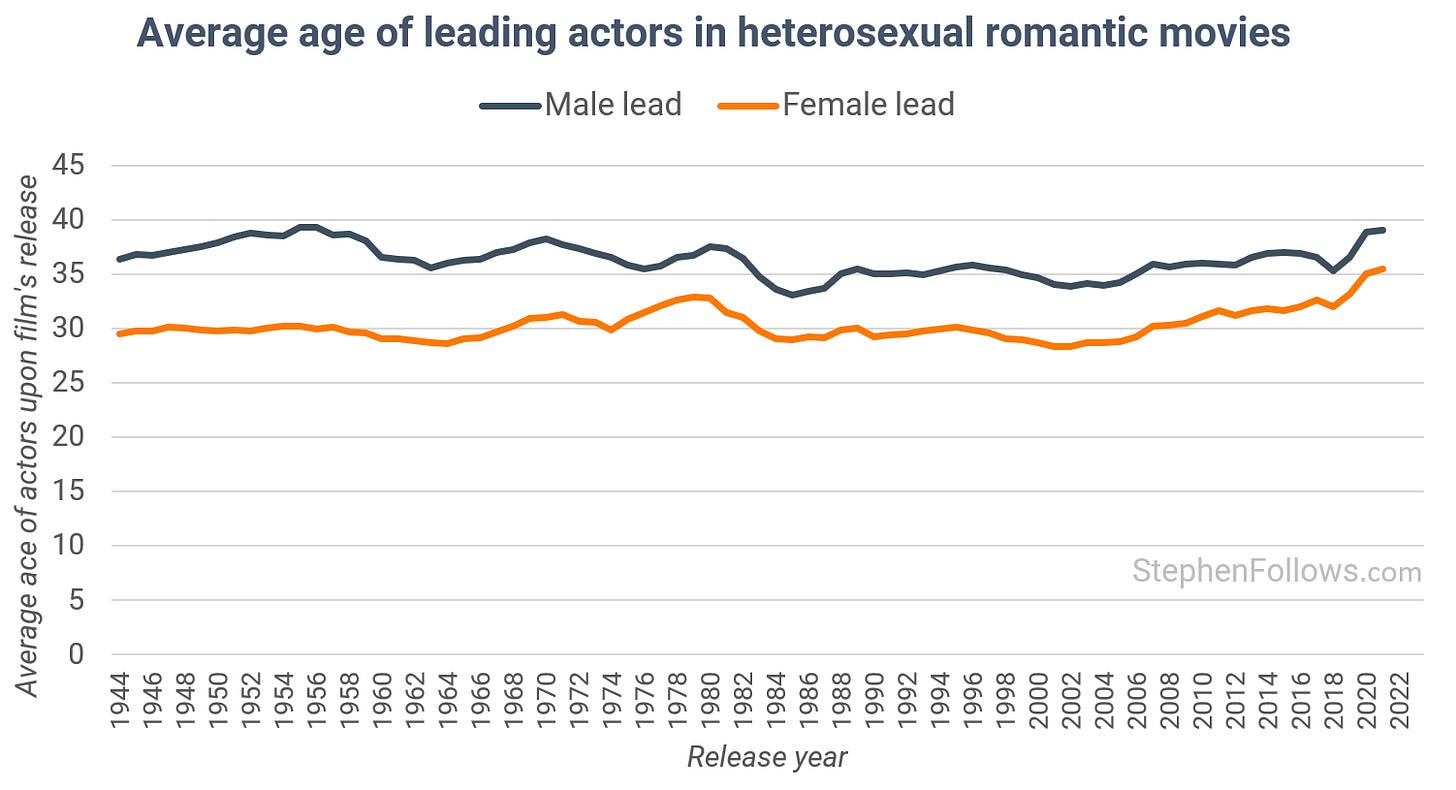
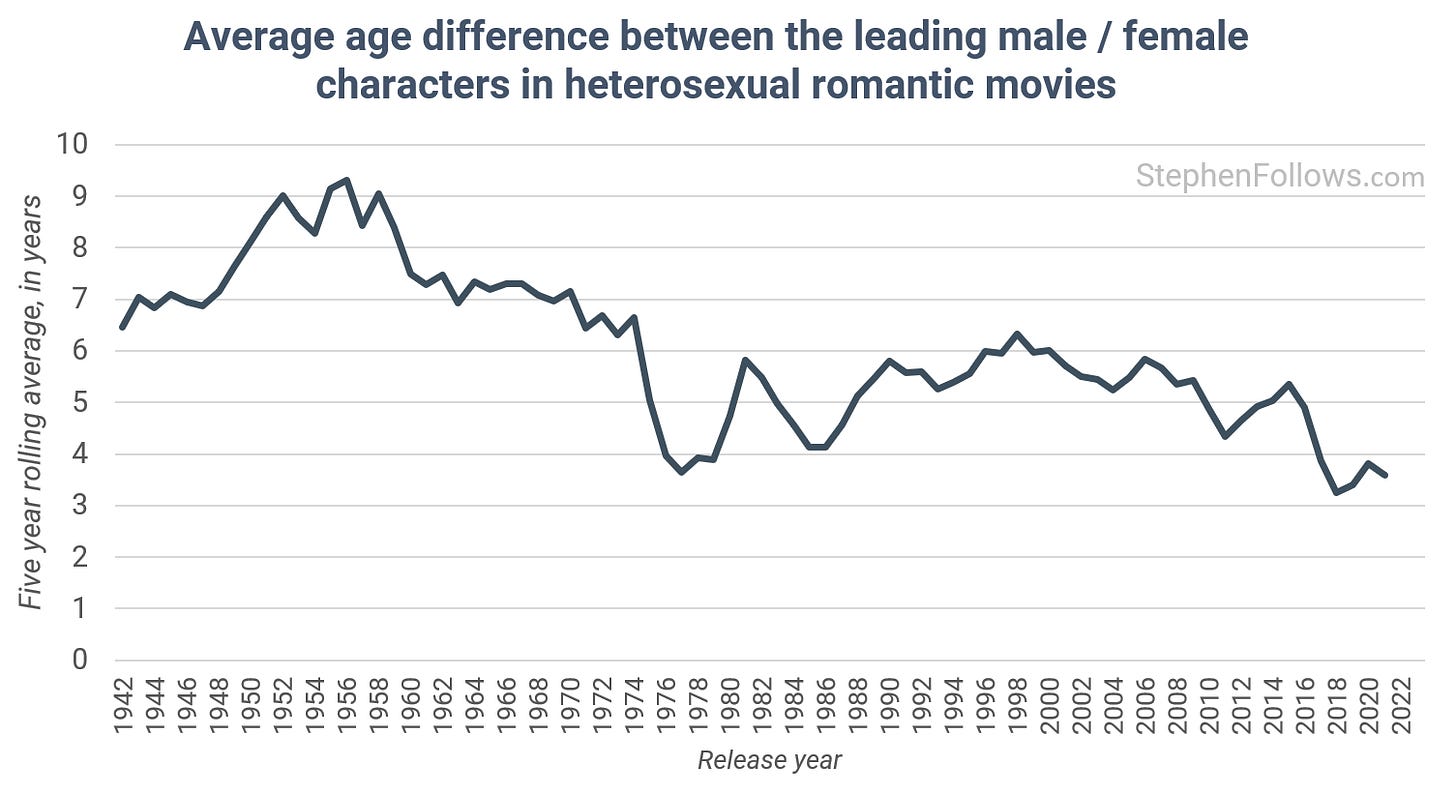
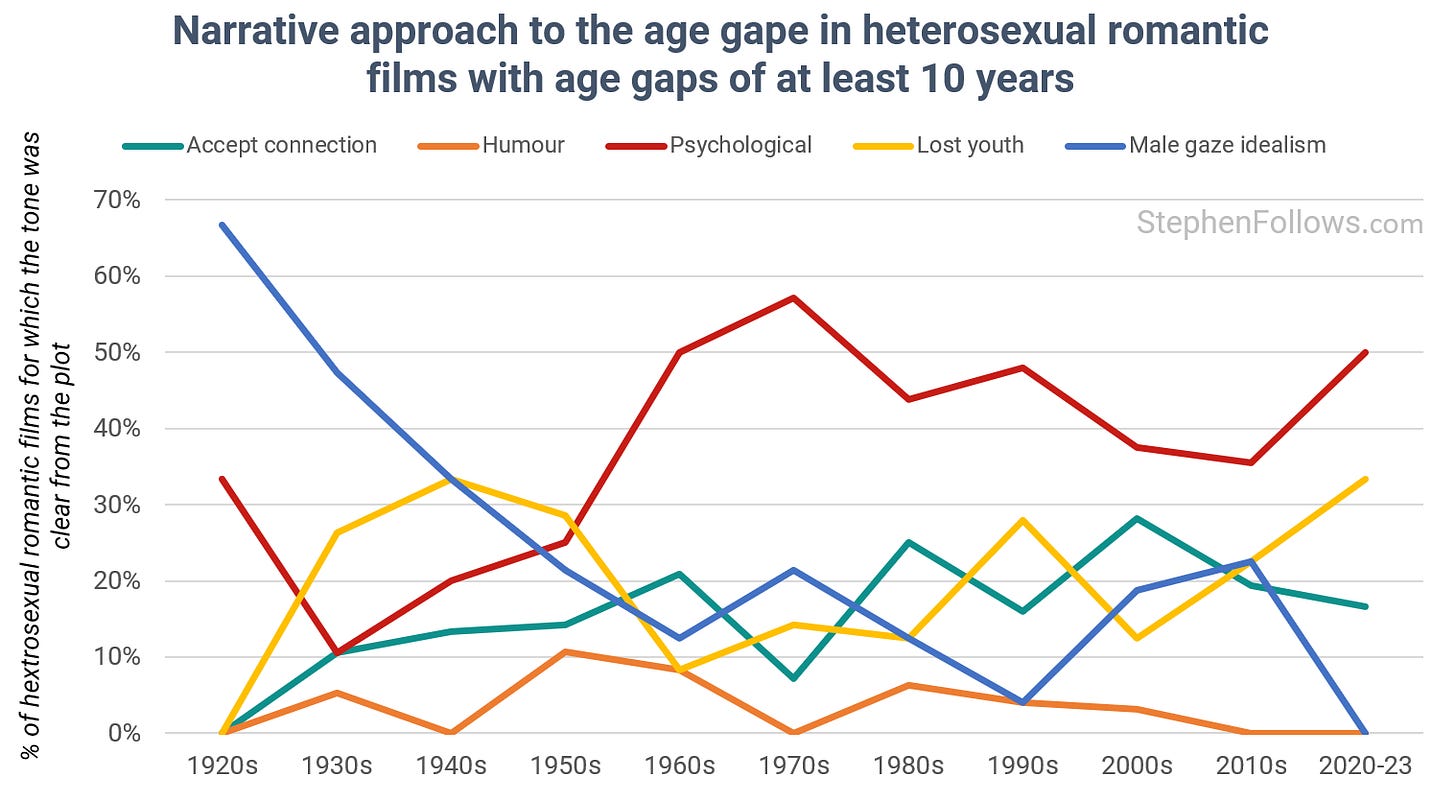
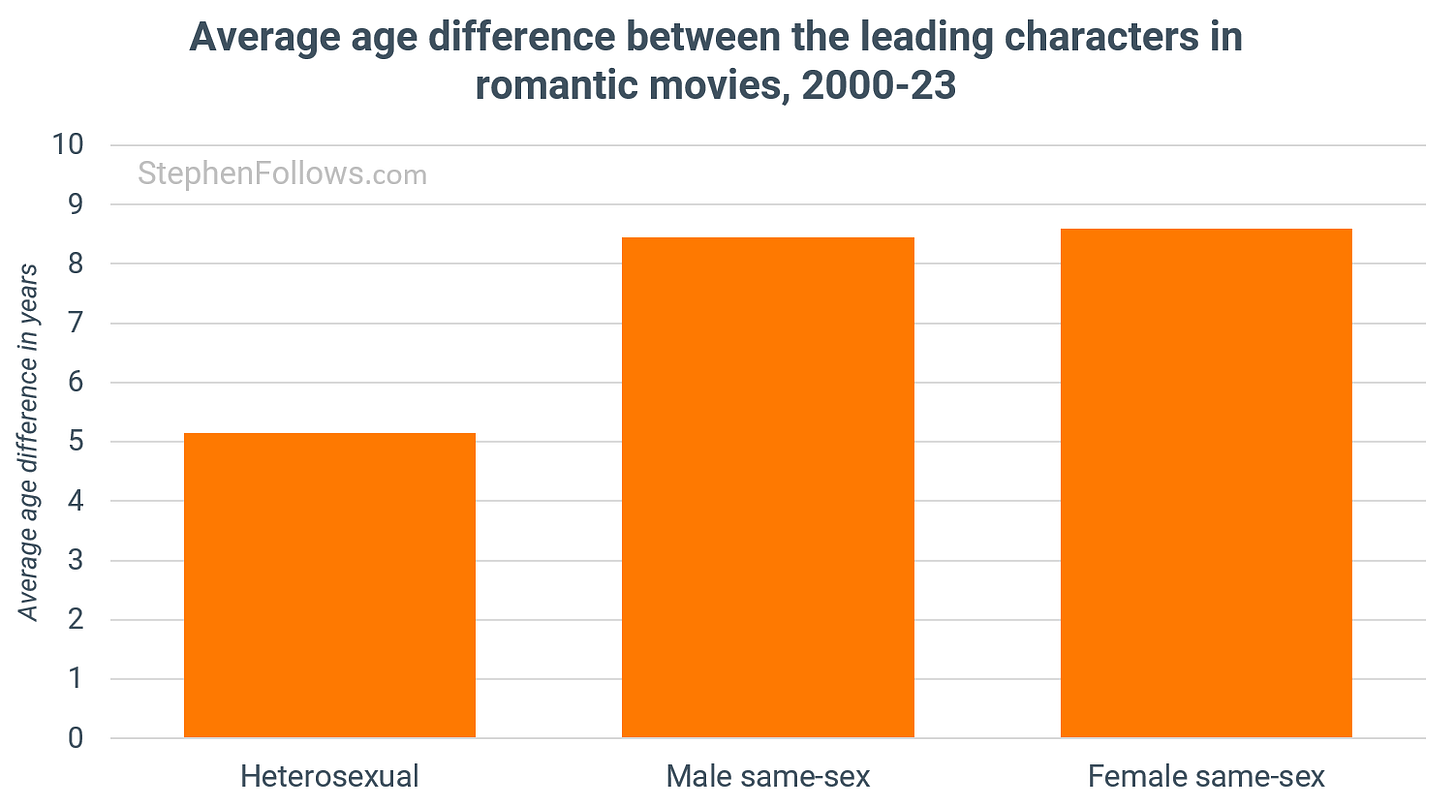
No, he's not right. It's one thing to compete with 25-year-old leading men, which doesn't make sense, but discounting romantic leads after 50 is silly. He was 53 when he married Amal. The thing that is getting tired is the gigantic age gaps between leading men and their leading ladies: 70-year-old leading men and 30-year-old leading ladies. But who would be mad at a Rom Com, or Romantic movie starring George Clooney and Halle Berry, or Brad Pitt and Selma Hayek? Just saying...
Thank you for this piece.
as usual, very good data analysis and interesting article.